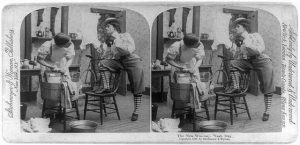

By Lena Wånggren
What is an ‘unwomanly’ woman? Or an ‘unsexed’ woman? At the end of the nineteenth century, both these terms were common invectives for any woman who went against the established gender ideals of the time. Meanwhile, some women were considered particularly ‘womanly’, engaging in professions and practices specifically suited to their supposed gendered nature, and others were oversexed, their gender spectacularised in new workplaces. My book Gender, Technology and the New Woman, published by EUP in May, concerns the ways in which women used modern technologies of the time to navigate the new and unstable gendered identities of the period.
In the late nineteenth century, the protofeminist literary figure of the New Woman became associated with specific modern technologies of the time, such as the typewriter, the bicycle, and medical technologies. Both as material object and as institutional technology, technologies of any time are bound up with the society in which they exist; material objects and institutions of the late nineteenth century are thus framed by the social, political, economic, and scientific contexts of the time. However, the same material objects may also be taken up, and institutional structures challenged, in order to rework these same structures. While nurses in the late nineteenth century were considered specifically suited to the ‘womanly’ profession of nursing, their entry into the clinical hospital challenged the hierarchical structures of that institution, by opening up a new space for working women in this previously male-coded sphere of medicine. Similarly, while female typists at work were simultaneously mechanised and sexualised, their place at the typewriter enabled them to enter the previously male-coded office space.
While entering the clinical hospital as a female doctor – as opposed to as a nurse – seemed to threaten established gender norms of the late nineteenth century, the single most frightening technology associated with female freedoms was the bicycle. The 1896 Handbook for Lady Cyclists describes some of the early fears that the bicycle might be ‘unsexing’ women: ‘It was openly said that a woman who mounted a bicycle hopelessly unsexed herself; she was stared at and remarked upon in town, and hooted and called after in country districts’ (Davidson 1896: 10). Women cyclists were ridiculed in the periodical press, as evidenced by a the 1895 satiric poem ‘Sexomania’ in the Punch magazine:
Bicycling, footballing, scarce human,
All wonder now ‘Which is the woman?’
But a new fear my bosom vexes;
To-morrow there may be no sexes!
Unless, as end to end all the pother,
Each one in fact becomes the other.
(‘Sexomania’ 1895: 203)
With women bicycling, the Punch satirist fears, tomorrow ‘there may be no sexes’. Or indeed, in a process of sex reversal, the woman and man might finally ‘in fact become[s] the other’. Another evidence of this feared sex reversal is the stereograph picture ‘The New Woman – Wash Day’ (c. 1897), in which the woman’s bicycling habits – coupled with her smoking and trouser-wearing – lead to her abandoning her husband to do the housework. While the periodical press ridiculed women’s uses of the bicycle, literary representations of women’s bicycling instead often emphasised the freedom that the machine offered.
While twentieth- and twenty-first-century feminists use contemporary technologies such as social media to continue the fight for gender equality, as my book shows, this tradition has a long history. Women today, especially feminists, still face criticism or abuse regarding their supposedly ‘unwomanly’ behaviour, just as many late nineteenth-century women’s rights campaigners did. While in most countries today women work in offices, as nurses and doctors, and ride bicycles, only a bit over 100 years ago this was a novelty. If history is anything to go by, in the not-too-distant future the abuse hurled at feminist campaigners today will seem just as ridiculous as the late nineteenth-century fears of women becoming ‘unsexed’ by bicycle-riding.
Lena Wånggren is a Research Fellow at the University of Edinburgh. Her research includes work on gender in nineteenth century literature and culture, feminist pedagogy, and the medical humanities.
Wånggren is a Research Fellow at the University of Edinburgh. Her research includes work on gender in nineteenth century literature and culture, feminist pedagogy, and the medical humanities.
Her monograph Gender, Technology and the New Woman publishes in May 2017.
Works cited
Davidson, Lillias Campbell (1896), Handbook for Lady Cyclists, London: Hay Nisbet.
‘The new woman – wash day’ (c. 1897), New York: Strohmeyer & Wyman. Stereographic print. http://www.loc.gov/pictures/item/90706169/
‘Sexomania. By an Angry Old Buffer’ (1895), Punch, or, the London Charivari, 27 April 1895, 203.





